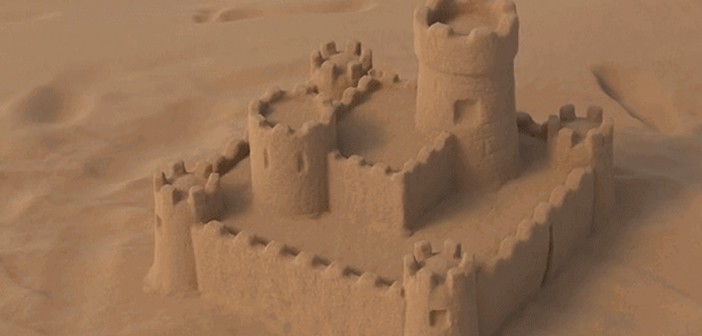Leading up to this year’s Siggraph conference—the biggest event of the year in computer graphics and experimental UI—Disney Research comes with a collection of new papers that delve into everything from new methods of 3-D printing action figures to better ways for us to render CGI eyelids.
Here’s a peek at the future it’s dreaming up.
A Sand Castle Rendered From 2 Billion Discrete Grains
Even for extremely powerful computers, rendering an object made of tiny particles, like grains of sand or flakes of snow, can be impractical. But researchers developed a system that—assuming we’re reading the extremely technical paper correctly—uses procedural generation to algorithmically arrange many similar particles to appear randomly at small scale. The result is a computational cutting of corners that your eye won’t notice.
Here, the video zooms into a castle built from 2 billion individual grains of sand, each of which are constructed from 200,000 triangles, and the effect is simply wild to behold. [Read more]
A Fabric Simulator Than An Idiot Could Program
Right now, if you want to use a 3-D program to simulate a particular type of fabric—from stiff denim to flowing silk—it requires countless tiny adjustments to esoteric values. But correctly simulating fabric is an important job, not just in animation, but even in the fashion industry, where more and more early modeling is done in 3-D.
Disney Research has developed a method that can work across 3-D programs to wrap all the esoteric rendering and physics terminology into words anyone can understand: Like “smooth,” “wrinkly,” “soft,” and “silky.” This approach vastly reduces the learning curve of accurately depicting 3-D fabrics. And don’t be surprised if, into the future, more image editing programs follow suit with more accessible diction. [Read more]
Bendable, 3-D Printed Figures
Say you want to 3-D print an object like an action figure that needs to have both hard parts and bendable parts. What do you do? You could get a 3-D printer that’s capable of printing with several different materials at the same time. Or, as Disney Research shows, you could use a single material and print some areas with a lot of density, and other areas as lattice structures that can bend and flex. [Read more]
Fake Eyelids That Will Make Your Real Eyes Water
Lifelike eyes are notoriously difficult to render, and eyelids are no easier. In response, Disney Research’s new technique captures the ticks and wrinkles in an actor’s eyelids and transfer those to an animated 3-D simulation. The result is so detailed it’s almost hard to look at, and it’s another necessary, small step in creating avatars that will help eliminate the uncanny valley and make us believe they’re human. [Read more]
A Super Camera Algorithm
Ever shoot a home video, and wish you could remove some stranger making a face at the camera? That’s the sort of thing that Disney Research’s latest visual algorithm can do. It creates an accurate 3-D map of a scene, just from 2-D image data. And with that map in-hand, it can eliminate objects or highlight subjects in a scene, without forcing you to dig through keyframes in After Effects. In this case, the work is a bit of convergent thinking. Microsoft Research is working on many similar concepts in their ICE software you can download today. [Read more]



